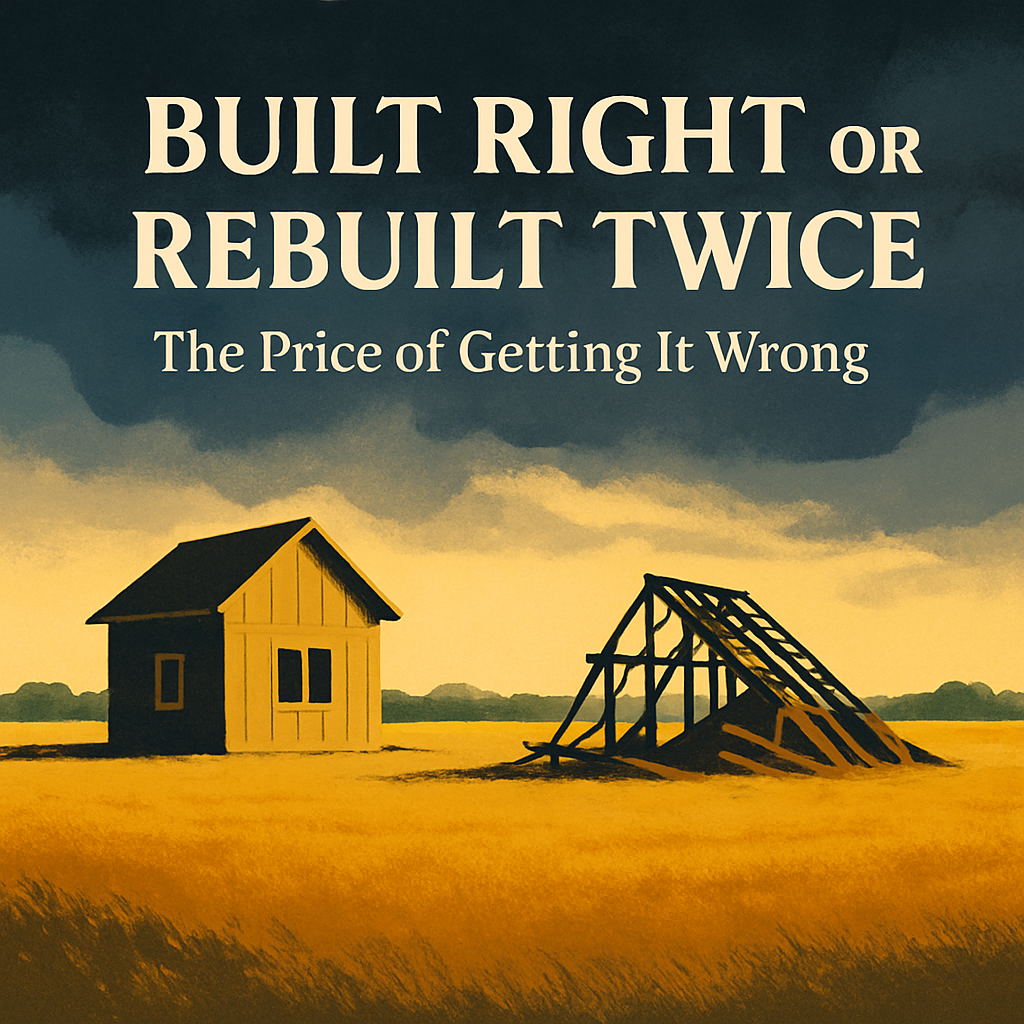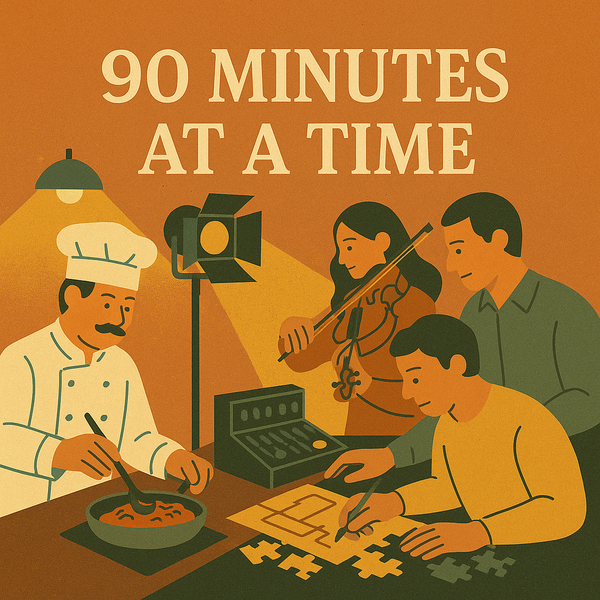Built Right or Rebuilt Twice: The Price of Getting It Wrong

In our fast paced world, the pressure to deliver quickly and cheaply often leads to shortcuts that seem like smart financial decisions. However, the old adage "you get what you pay for" holds more truth than many realize. Doing something right the first time is not just about quality, it is about economics.
The Hidden Mathematics of Quality
When we cut corners to save money upfront, we are essentially borrowing from our future selves. The classic project management adage states: "Fast, cheap, good, pick any two." This quality triangle reveals a fundamental truth about resource allocation. You can have something done quickly and cheaply, but it will not be good. You can have it done quickly and well, but it will not be cheap. Or you can have it done cheaply and well, but it will not be fast.
However, this triangle only describes the immediate transaction. When we factor in the total cost of ownership over time, the mathematics change dramatically. Consider home construction: using substandard materials might save 15% on initial costs, but the resulting repairs, replacements, and energy inefficiencies can cost 200 to 300% more over the building's lifetime. This pattern repeats across industries, from software development to manufacturing.
A striking example comes from church sound systems, where acoustic consultant Jim Brown notes that most churches buy three or four sound systems before finally getting one that works. The first system is typically designed by whoever offers the lowest bid, often someone with little relevant experience. When it inevitably fails to meet the church's needs due to feedback, poor intelligibility, and sound quality issues, they purchase a second system, usually designed by a well meaning friend or congregation member who lacks specialized expertise. Only after wasting money on two failed systems do they finally hire a qualified acoustic consultant who can design a system that actually works.
The Domino Effect of Poor Decisions
Quality problems rarely exist in isolation. When one component fails due to poor initial execution, it creates a cascade of additional issues. A poorly installed roof does not just leak, it damages insulation, creates mold problems, ruins interior finishes, and potentially compromises structural integrity. Each failure point multiplies the total cost exponentially.
This domino effect extends beyond physical products. In business processes, shortcuts in employee training lead to higher turnover, reduced productivity, customer service issues, and compliance problems. The interconnected nature of modern systems means that one weak link can compromise entire operations.
Time as a Financial Resource
The quality triangle's emphasis on time as a constraint reveals another dimension of why doing things right matters. When we rush through tasks or use inadequate methods, we inevitably spend more time later fixing, replacing, or working around the problems we created. This time has an opportunity cost: every hour spent fixing yesterday's shortcuts is an hour not spent on growth, innovation, or value creation.
The church sound system example illustrates this perfectly. Churches that choose the "fast and cheap" option from the quality triangle end up spending years dealing with poor sound quality, frustrated congregations, and multiple system replacements. Meanwhile, churches that invest properly upfront can focus their time and energy on their core mission rather than constantly troubleshooting audio problems.
Professional services understand this principle well. A thorough initial consultation might take longer and cost more upfront, but it prevents the expensive revisions and scope creep that plague rushed projects. The additional time invested in planning and preparation pays dividends throughout the entire project lifecycle.
The Reputation Premium
Quality work builds reputation, and reputation commands premium pricing. Companies known for doing things right the first time can charge more because customers trust them to deliver value. This creates a positive feedback loop: higher prices enable better quality, which enhances reputation, which supports even higher prices.
Conversely, businesses that cut corners often find themselves trapped in a race to the bottom. They compete primarily on price, which forces them to cut more corners, leading to quality problems that further damage their reputation and force them to compete even more aggressively on price.
Risk Management Through Quality
Doing things right the first time is fundamentally about risk management. Quality work reduces the probability of failures, delays, safety issues, and compliance problems. While this risk reduction might not show up immediately on a balance sheet, it represents real financial value in avoided costs.
Insurance companies understand this principle intimately. They offer lower premiums to customers who demonstrate good risk management practices because they know that prevention is far cheaper than claims. The same logic applies to every aspect of business and personal finance.
Knowledge vs. Wisdom in Decision Making
There is an old saying that perfectly captures why doing things right requires more than just information: "Knowledge is knowing a tomato is a fruit; wisdom is not putting it in the fruit salad." This distinction between knowledge and wisdom lies at the heart of why so many well intentioned projects fail despite access to all the right technical information.
Knowledge tells us the specifications, features, and capabilities of different options. Wisdom tells us which of those options will actually serve our real world needs. In the church sound system example, knowledge might be understanding decibel ratings, frequency responses, and power specifications. Wisdom is recognizing that all those technical details are meaningless without someone who understands how sound behaves in your specific worship space.
The Investment Mindset
The key to understanding why quality pays is shifting from an expense mindset to an investment mindset. When we view quality as an investment rather than a cost, we naturally consider the long term returns. A more expensive tool that lasts ten times longer is not costly, it is profitable. A thorough training program that reduces turnover is not overhead, it is a strategic investment.
The church sound system example illustrates this perfectly. While hiring a qualified acoustic consultant costs more upfront than accepting a "free" design from a contractor, the consultant's fee is a fraction of what churches spend buying multiple failed systems. The consultant's expertise in room acoustics, speaker placement, and system design prevents the costly cycle of replacement and rework that plagues churches who choose based on initial price alone.
This investment mindset helps us make better decisions about where to allocate resources. Not everything requires premium quality, but understanding the total cost of ownership helps us identify where quality investments will pay the highest returns.
Building Systems for Success
Organizations that consistently do things right the first time do not achieve this through heroic individual efforts, they build systems that make quality the natural outcome. These systems include proper planning processes, adequate resource allocation, clear quality standards, regular training, and feedback mechanisms that catch problems early.
The upfront investment in these systems might seem expensive, but they eliminate the much higher costs of constant firefighting, rework, and crisis management. Companies with mature quality systems spend their time and resources on growth and innovation rather than fixing preventable problems.
Conclusion: The Compound Returns of Quality
Doing things right the first time creates compound returns that extend far beyond the immediate financial savings. It builds reputation, reduces stress, creates competitive advantages, and frees up resources for growth and innovation. While the upfront investment might be higher, the long term financial benefits make it one of the most reliable investment strategies available.
The next time you are tempted to take a shortcut to save money, remember that you are not actually saving, you are borrowing from your future self at extremely high interest rates. True economy lies not in spending less, but in getting more value from what you spend. In the end, quality is not expensive, it is priceless.




